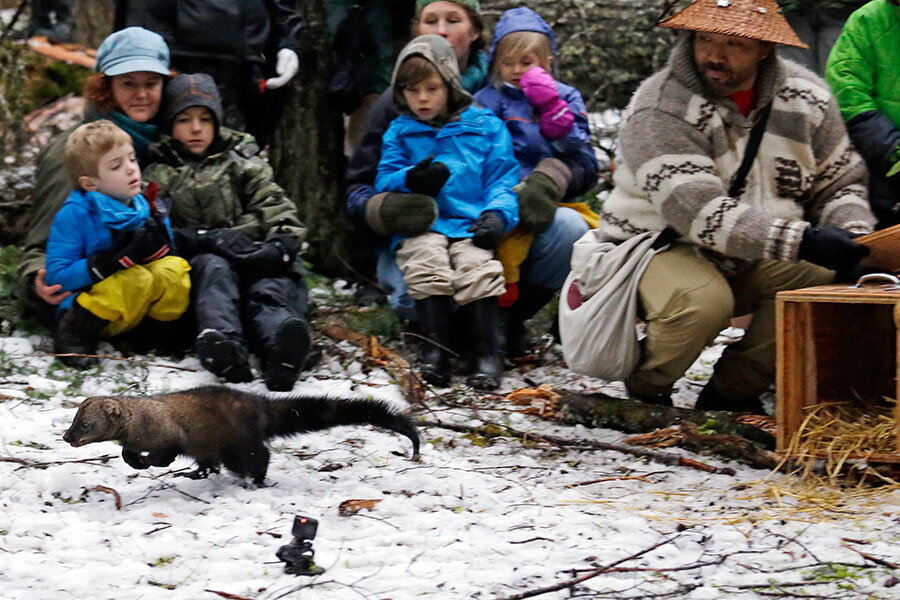Pacific fisher reintroduction: Not just an ecological victory, but a cultural one
Loading...
When fishers finally returned to Washington, it wasn’t the muted affair typical of conservation work. Instead, these fuzzy settlers were met with ceremonial drums and the cheers of 100 onlookers.
On Friday, wildlife officials released 10 fishers, the second-largest member of the weasel family, to Mount Rainier National Park. As the fishers emerged from their cages, Nisqually elders cued them with soft-beating drums. They were the first of their kind to set foot there in nearly 80 years, having been hunted to statewide extinction by fur trappers in the mid-1900s.
This was the latest step in a 15-year effort by the Washington Department of Fish and Wildlife (WDFW), the National Park Service, and non-profit Conservation Northwest to reintroduce the species to the state. But for the Nisqually Indian Tribe, repopulation could also mean the return of an important cultural and spiritual symbol – an important aspect of the conversation that is often lost in the shuffle of science.
Fishers live throughout Canada and the northern United States, growing to roughly the size of a domestic cat. These agile mammals offer improved biodiversity to their native forests, mainly hunting porcupines and snowshoe hare but feeding on mushrooms and fruit as necessary. Though sometimes called “fisher cats,” fishers are not feline and do not eat fish.
Traditionally, the Coast Salish peoples have called fishers by another name: sxwemechen. These indigenous people of the Pacific Northwest associate the sxwemechen with certain powers, working depictions of them into house posts and other art. So when fishers were released on Nisqually land after decades of absence, there was reason to celebrate.
“It filled my heart with joy,” Jackie Wall, a Nisqually tribe elder, told the Seattle Times. “It’s the only area in the park you can see the [Nisqually] river and the mountain. It’s really bringing them home.”
The release was also a powerful moment of concurrence between scientists and indigenous peoples, who have sometimes applied starkly different perspectives to the same conservation goals.
In many native American cultural traditions, animals are considered non-human persons. These “animal people” are both intelligent and spiritually powerful, and as such, human people have various social obligations to them, explains Paul Nadasdy, a professor of anthropology and American Indian studies at Cornell University. Most scientific wildlife managers, by comparison, tend not to view human-animal relations as social in nature.
“From the perspective of many of the First Nation people I work with in the Yukon, ‘wildlife management’ is at least as much about maintaining proper social relations with animal people as it is about managing the demographics of a population whose size and health is linked exclusively to ‘objective’ factors such as birth and mortality rates, habitat, and predation,” Dr. Nadasdy tells The Christian Science Monitor in an email.
That’s why scientific wildlife management, Nadasdy suggests, doesn’t always square with the practices of people who have traditionally hunted or fished for a living.
“The result is that sometimes the interests and objectives of wildlife managers can appear to align nicely with those of First Nations, while at other times they can find themselves opposing one another,” Nadasdy says. “One good example of this is that First Nation people in the Yukon generally oppose the radio-collaring of animals, because they feel this is intrusive and disrespectful of animals.”
A time to act
When fishers first went extinct in Washington, there was little regulation in place that could have saved the squirly mammal. But tighter environmental legislation, coupled with the recent trend of “rewilding,” could create the perfect conditions for repopulation.
“A lot of the things that could be negative to fishers either no longer occur, or are so insignificant that they wouldn’t affect the establishment of a population,” WDFW biologist Jeff Lewis tells the Monitor in a phone interview. “There’s no trapping season for fishers. Trapping in Washington involves only cage traps now, so that’s an additional protection. Fishers are now listed as state endangered species.”
Fishers generally steer clear of people, so the project hasn’t prompted much pushback from nearby communities. But while the released fishers have mostly remained in their designated area, it’s possible that they will eventually roam into private timberlands. That could be problematic for timber companies, who may find it more difficult to operate in the region under federal regulations designed to protect the species.
“State and federal agencies have been working hard to prepare for this likelihood and reduce impacts on both fishers and landowners,” Chase Gunnell, a spokesperson for Conservation Northwest, tells the Monitor. “So far over two dozen private forest owners have signed up through the Washington Department of Fish and Wildlife in Candidate Conservation Agreement with Assurances (CCAA) programs, a proactive, voluntary program that will exempt qualified landowners from land use restrictions that may result if Washington's fishers are ever listed under the federal Endangered Species Act.”
But Dr. Lewis and his project team – which includes Dave Werntz from Conservation Northwest, Tara Chestnut of Mt. Rainier National Park, and Jason Ransom of North Cascades National Park – are mostly focused on the numbers game now. To ensure the population remains large enough to self-sustain, the team will monitor each released individual.
“You don’t want to shortchange your project by not putting enough animals out there,” Lewis says. “There’s a bottleneck effect with new populations, so there’s going to be mortality. You can’t expect them to behave like resident populations right away, in terms of survival and reproduction. It takes time for that to happen, so we’ve got to wait a while to track that.”






